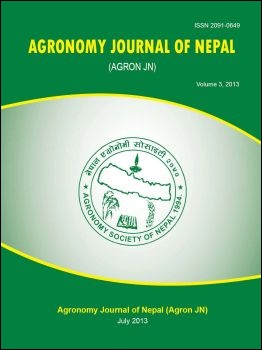Modeling the sensitivity of CERES-Rice model: An experience of Nepal
DOI:
https://doi.org/10.3126/ajn.v3i0.8982Keywords:
CERES-Rice, sensitivity, yield, cultivarsAbstract
The experiment was conducted with four levels of nitrogen (40, 80,120 and 160 kg/ha) and 3 different cultivars (Prithivi hybrid), Masuli (HYV) and Sunaulo Sugandha (Aromatic).RMSE value (747.35 kg/ha, 1.106 days, 2.58 days and 0.004 kg/ha) and D-stat value (0.793, 0.99, 0.99 and 0.633) for grain yield, anthesis days, maturity days, and individual grain weight respectively. The objective of this study was to identify whether CSM-CERES-Rice model can be used in Nepalese condition and to evaluate the sensitivity of model with impact of climate change on rice production. Eight different climate scenarios were built by perturbing maximum and minimum temperature (± 4°C), CO2 (± 20ppm), solar radiation (±1MJ/m2/day) using interactive sensitivity analysis mode in DSSAT. Among the scenario evaluated, temperature (± 40°C), CO2 concentration (+20 ppm) with change in solar radiation (±1MJ m-2 day-1) resulted maximum increase in yield (by 62, 41 and 42%) under decreasing climatic scenarios and sharp decline in yield (by 80, 46 and 40%) was observed under increasing climate change scenarios, in Prithivi, Masuli and Sunaulo Sugandha cultivars respectively.Not surprisingly, increasing yield by (48, 25 and 27 %) and decrease in yield by(77, 41 and 34) by perturbing only maximum and minimum temperature by (± 4) shows that the temperature is most sensitive for yield potentiality of cultivars than other. CERES-Riceversion 4.0 was well calibrated in Chitwan Nepal condition. The model applications show that model could be a tool for precision decision-making. There was variation in yield in response to the change in climatic scenario in the study. RMSE value (747.4 kg/ha, 1.11days, and 2.58 days), and d-stat (0.79, 0.99 and 0.99) for grain yield, anthesis, and maturity days confirm the possibility of CERESRiceuse in Nepalese agriculture. The finding showed that there was sharp decrease in rice yield due to change in temperature, CO2 and solar radiation. Climatic scenario developed by CERES-Rice model in sensitivity analysis resulted yield reduction up to 80%. Among the cultivar, hybrid rice shows more vulnerability with climate change. Decrease in yield were mainly associated with lowering growth duration along with increasing temperature, where as there is very less counter effect of increasing carbon dioxide concentration and solar radiation.
Agronomy Journal of Nepal (Agron JN) Vol. 3. 2013, Page 11-22
Downloads
Downloads
Published
How to Cite
Issue
Section
License
ASON permits for free use, distribution and reproduction in any medium if the original work is properly cited and not used for commercial purposes.




